Impact of Gender Discrimination on Diversity: M&S Case Study Report
VerifiedAdded on 2023/01/13
|34
|8201
|2
Report
AI Summary
This research project investigates gender-based discrimination and its effects on workplace diversity and equality, using Marks and Spencer (M&S) as a case study. The introduction outlines the importance of diversity and equality, setting the aim to determine the impact of gender-based discrimination within the organization. The literature review explores themes such as the impact of gender discrimination on equality and diversity, and the advantages of diversity and equality in the workplace. The research methodology section details the chosen qualitative research method, interpretivism philosophy, exploratory research design, and inductive research approach. The project utilizes primary data collection through questionnaires and thematic analysis for data interpretation. The report also includes a timeline, Gantt chart, ethical considerations, and appendices, offering a comprehensive analysis of gender-based discrimination and its implications for workplace dynamics. The findings, outcomes, and conclusion sections summarize the research and provide recommendations.
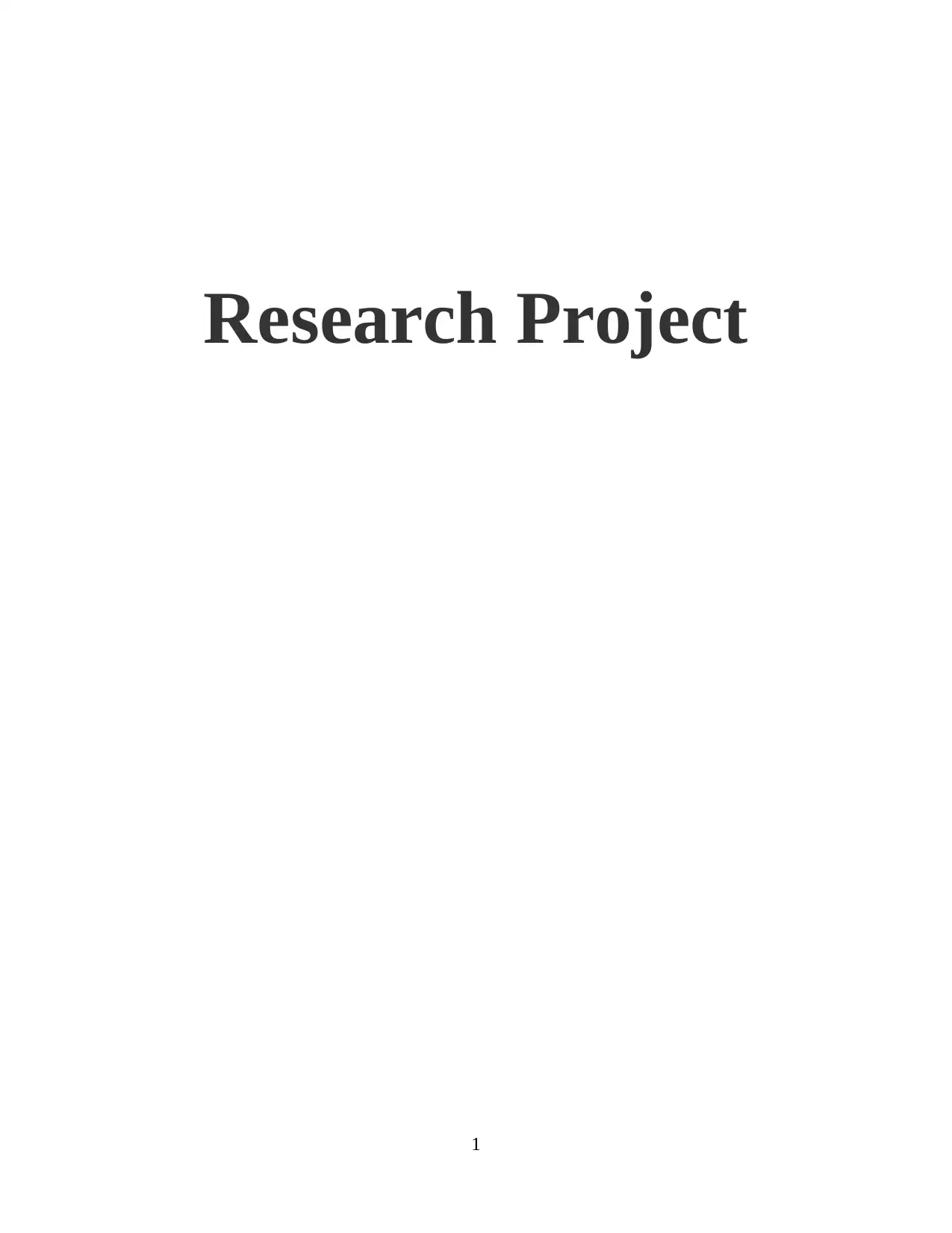
Research Project
1
1
Paraphrase This Document
Need a fresh take? Get an instant paraphrase of this document with our AI Paraphraser
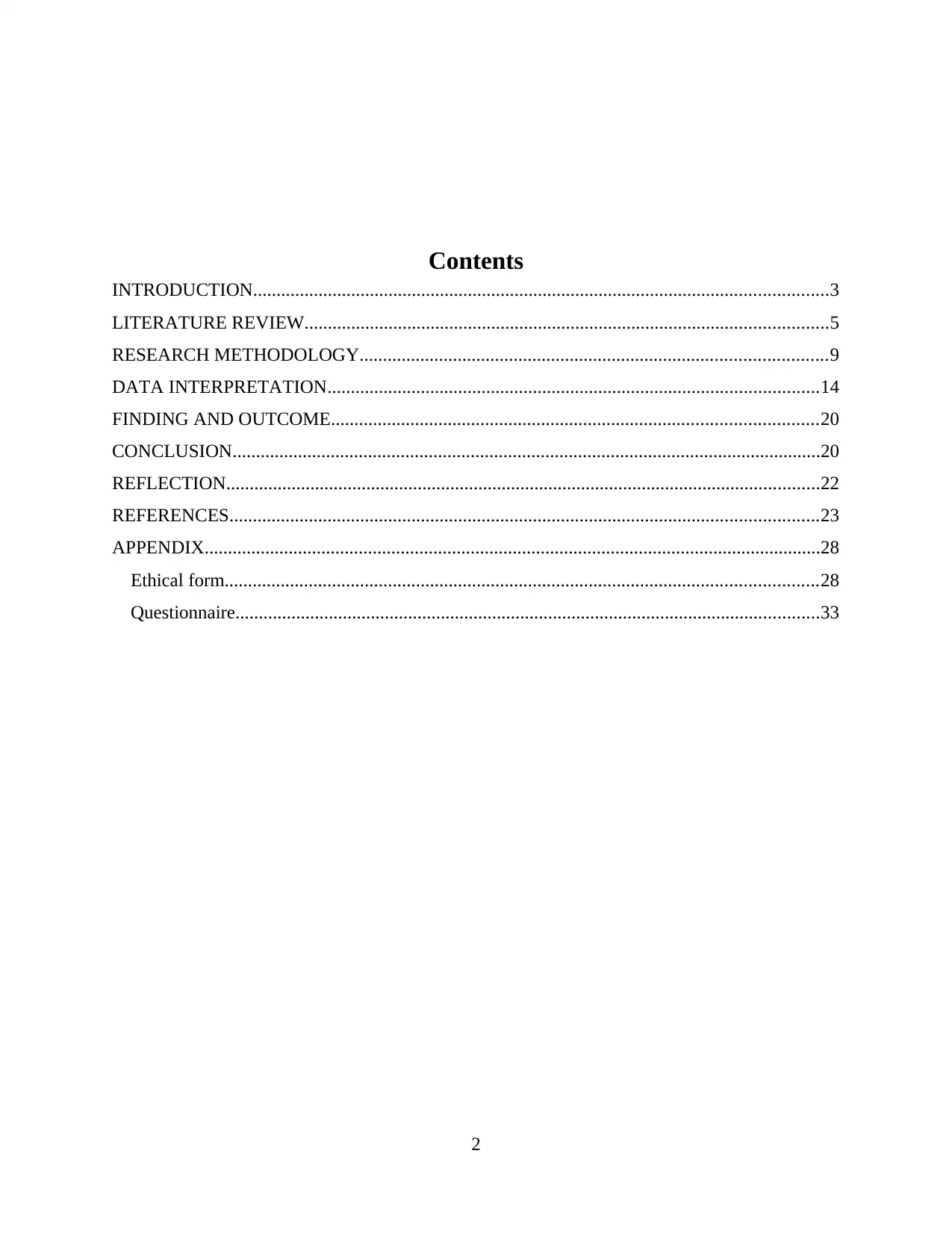
Contents
INTRODUCTION...........................................................................................................................3
LITERATURE REVIEW................................................................................................................5
RESEARCH METHODOLOGY....................................................................................................9
DATA INTERPRETATION.........................................................................................................14
FINDING AND OUTCOME........................................................................................................20
CONCLUSION..............................................................................................................................20
REFLECTION...............................................................................................................................22
REFERENCES..............................................................................................................................23
APPENDIX....................................................................................................................................28
Ethical form...............................................................................................................................28
Questionnaire.............................................................................................................................33
2
INTRODUCTION...........................................................................................................................3
LITERATURE REVIEW................................................................................................................5
RESEARCH METHODOLOGY....................................................................................................9
DATA INTERPRETATION.........................................................................................................14
FINDING AND OUTCOME........................................................................................................20
CONCLUSION..............................................................................................................................20
REFLECTION...............................................................................................................................22
REFERENCES..............................................................................................................................23
APPENDIX....................................................................................................................................28
Ethical form...............................................................................................................................28
Questionnaire.............................................................................................................................33
2
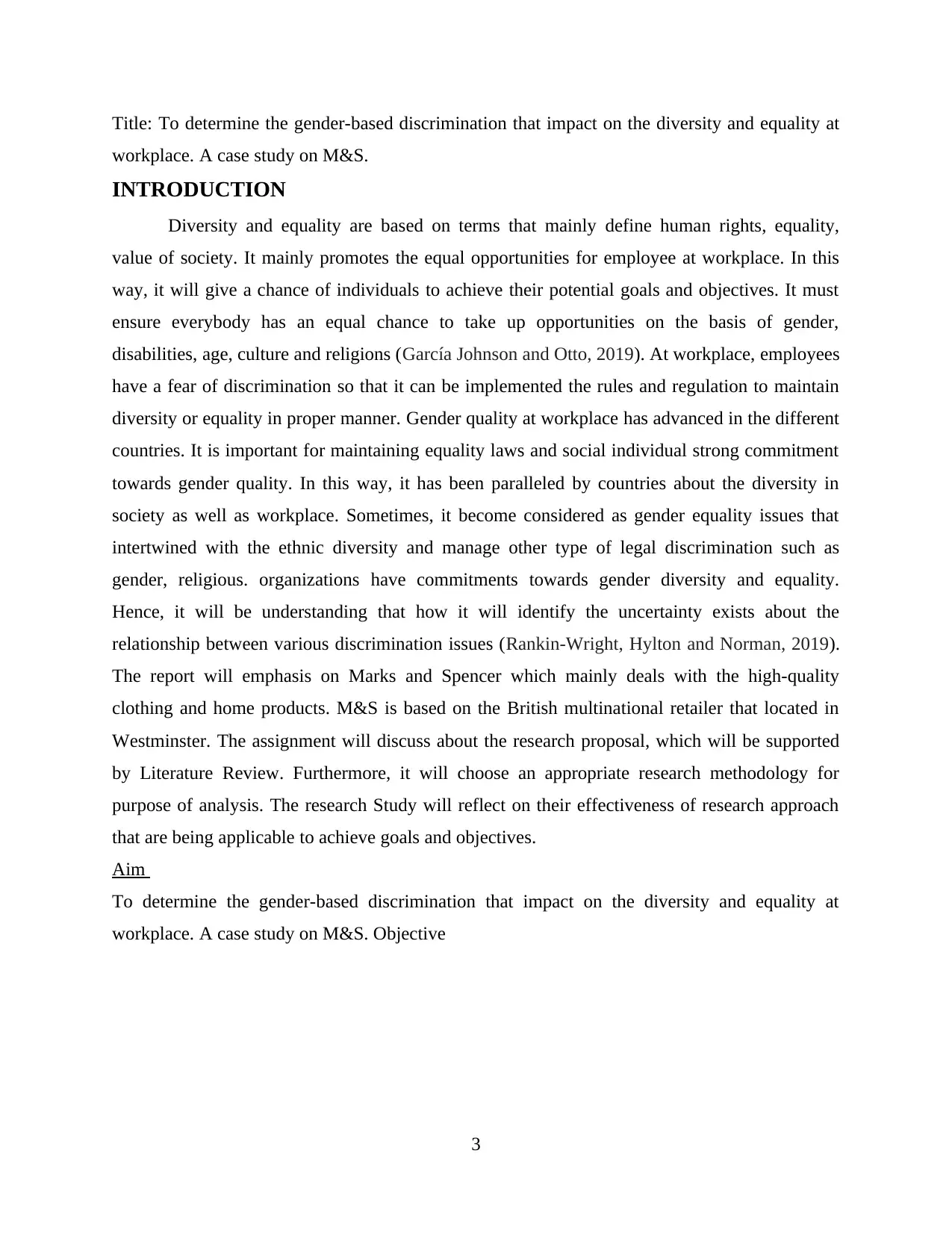
Title: To determine the gender-based discrimination that impact on the diversity and equality at
workplace. A case study on M&S.
INTRODUCTION
Diversity and equality are based on terms that mainly define human rights, equality,
value of society. It mainly promotes the equal opportunities for employee at workplace. In this
way, it will give a chance of individuals to achieve their potential goals and objectives. It must
ensure everybody has an equal chance to take up opportunities on the basis of gender,
disabilities, age, culture and religions (García Johnson and Otto, 2019). At workplace, employees
have a fear of discrimination so that it can be implemented the rules and regulation to maintain
diversity or equality in proper manner. Gender quality at workplace has advanced in the different
countries. It is important for maintaining equality laws and social individual strong commitment
towards gender quality. In this way, it has been paralleled by countries about the diversity in
society as well as workplace. Sometimes, it become considered as gender equality issues that
intertwined with the ethnic diversity and manage other type of legal discrimination such as
gender, religious. organizations have commitments towards gender diversity and equality.
Hence, it will be understanding that how it will identify the uncertainty exists about the
relationship between various discrimination issues (Rankin-Wright, Hylton and Norman, 2019).
The report will emphasis on Marks and Spencer which mainly deals with the high-quality
clothing and home products. M&S is based on the British multinational retailer that located in
Westminster. The assignment will discuss about the research proposal, which will be supported
by Literature Review. Furthermore, it will choose an appropriate research methodology for
purpose of analysis. The research Study will reflect on their effectiveness of research approach
that are being applicable to achieve goals and objectives.
Aim
To determine the gender-based discrimination that impact on the diversity and equality at
workplace. A case study on M&S. Objective
3
workplace. A case study on M&S.
INTRODUCTION
Diversity and equality are based on terms that mainly define human rights, equality,
value of society. It mainly promotes the equal opportunities for employee at workplace. In this
way, it will give a chance of individuals to achieve their potential goals and objectives. It must
ensure everybody has an equal chance to take up opportunities on the basis of gender,
disabilities, age, culture and religions (García Johnson and Otto, 2019). At workplace, employees
have a fear of discrimination so that it can be implemented the rules and regulation to maintain
diversity or equality in proper manner. Gender quality at workplace has advanced in the different
countries. It is important for maintaining equality laws and social individual strong commitment
towards gender quality. In this way, it has been paralleled by countries about the diversity in
society as well as workplace. Sometimes, it become considered as gender equality issues that
intertwined with the ethnic diversity and manage other type of legal discrimination such as
gender, religious. organizations have commitments towards gender diversity and equality.
Hence, it will be understanding that how it will identify the uncertainty exists about the
relationship between various discrimination issues (Rankin-Wright, Hylton and Norman, 2019).
The report will emphasis on Marks and Spencer which mainly deals with the high-quality
clothing and home products. M&S is based on the British multinational retailer that located in
Westminster. The assignment will discuss about the research proposal, which will be supported
by Literature Review. Furthermore, it will choose an appropriate research methodology for
purpose of analysis. The research Study will reflect on their effectiveness of research approach
that are being applicable to achieve goals and objectives.
Aim
To determine the gender-based discrimination that impact on the diversity and equality at
workplace. A case study on M&S. Objective
3
⊘ This is a preview!⊘
Do you want full access?
Subscribe today to unlock all pages.

Trusted by 1+ million students worldwide
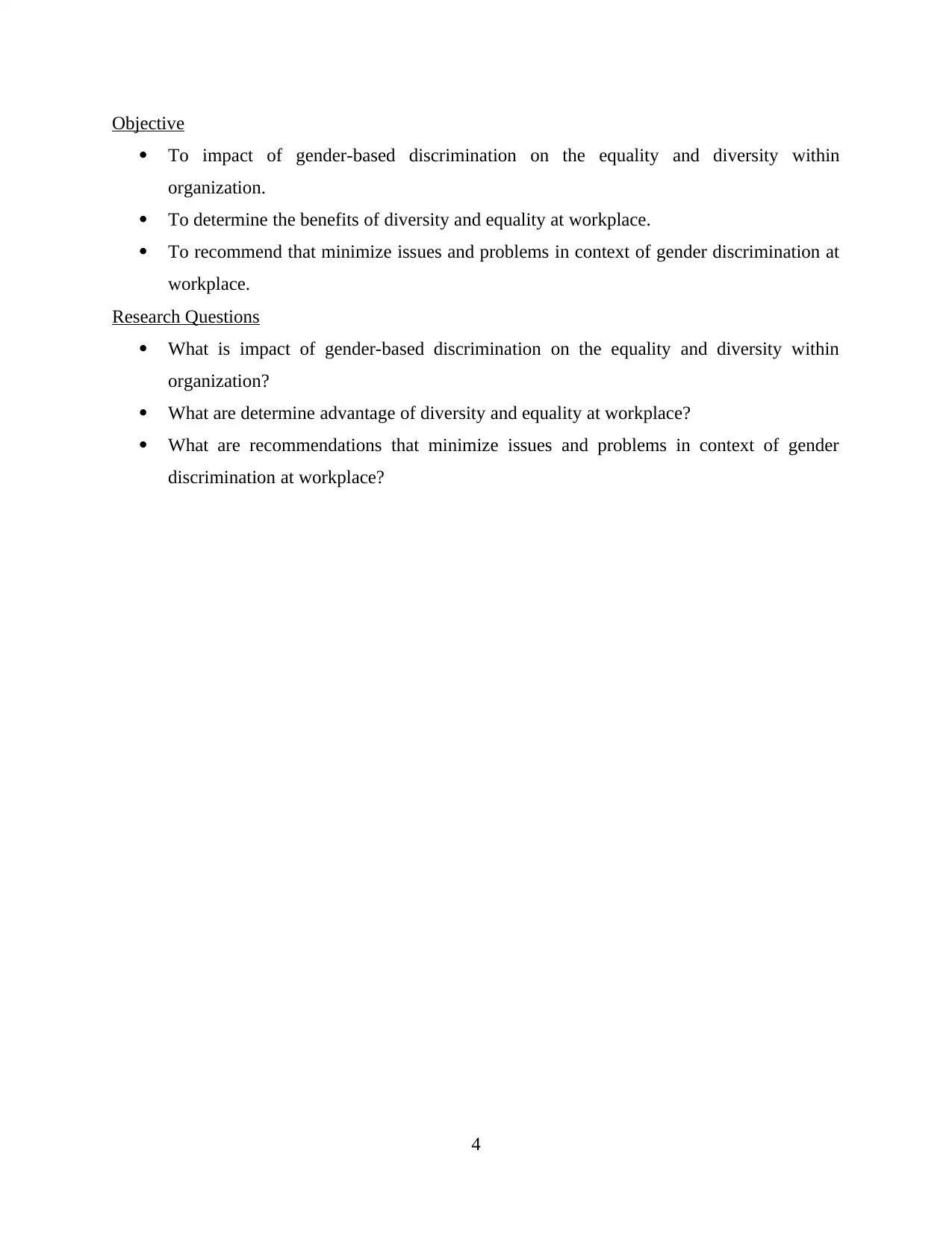
Objective
To impact of gender-based discrimination on the equality and diversity within
organization.
To determine the benefits of diversity and equality at workplace.
To recommend that minimize issues and problems in context of gender discrimination at
workplace.
Research Questions
What is impact of gender-based discrimination on the equality and diversity within
organization?
What are determine advantage of diversity and equality at workplace?
What are recommendations that minimize issues and problems in context of gender
discrimination at workplace?
4
To impact of gender-based discrimination on the equality and diversity within
organization.
To determine the benefits of diversity and equality at workplace.
To recommend that minimize issues and problems in context of gender discrimination at
workplace.
Research Questions
What is impact of gender-based discrimination on the equality and diversity within
organization?
What are determine advantage of diversity and equality at workplace?
What are recommendations that minimize issues and problems in context of gender
discrimination at workplace?
4
Paraphrase This Document
Need a fresh take? Get an instant paraphrase of this document with our AI Paraphraser
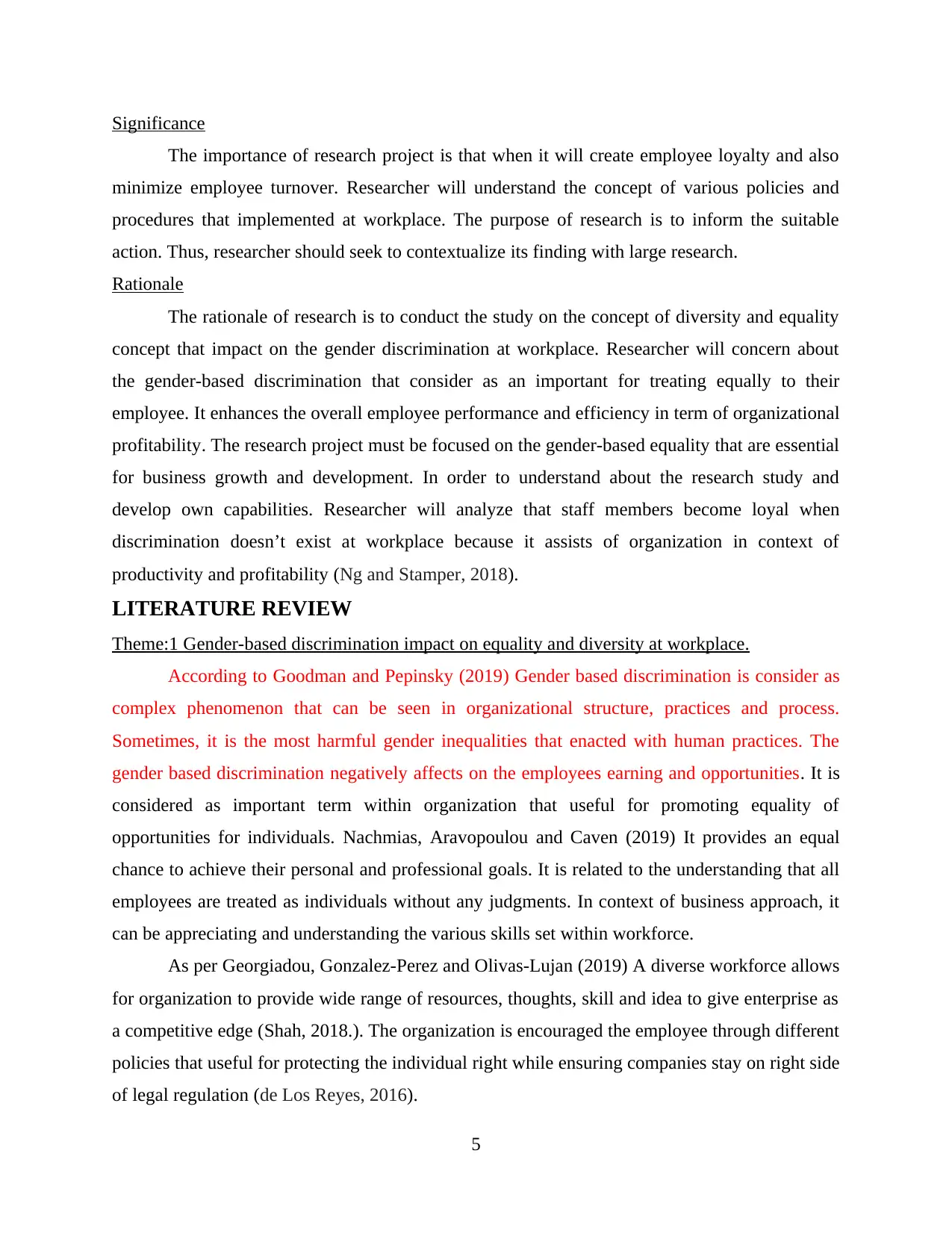
Significance
The importance of research project is that when it will create employee loyalty and also
minimize employee turnover. Researcher will understand the concept of various policies and
procedures that implemented at workplace. The purpose of research is to inform the suitable
action. Thus, researcher should seek to contextualize its finding with large research.
Rationale
The rationale of research is to conduct the study on the concept of diversity and equality
concept that impact on the gender discrimination at workplace. Researcher will concern about
the gender-based discrimination that consider as an important for treating equally to their
employee. It enhances the overall employee performance and efficiency in term of organizational
profitability. The research project must be focused on the gender-based equality that are essential
for business growth and development. In order to understand about the research study and
develop own capabilities. Researcher will analyze that staff members become loyal when
discrimination doesn’t exist at workplace because it assists of organization in context of
productivity and profitability (Ng and Stamper, 2018).
LITERATURE REVIEW
Theme:1 Gender-based discrimination impact on equality and diversity at workplace.
According to Goodman and Pepinsky (2019) Gender based discrimination is consider as
complex phenomenon that can be seen in organizational structure, practices and process.
Sometimes, it is the most harmful gender inequalities that enacted with human practices. The
gender based discrimination negatively affects on the employees earning and opportunities. It is
considered as important term within organization that useful for promoting equality of
opportunities for individuals. Nachmias, Aravopoulou and Caven (2019) It provides an equal
chance to achieve their personal and professional goals. It is related to the understanding that all
employees are treated as individuals without any judgments. In context of business approach, it
can be appreciating and understanding the various skills set within workforce.
As per Georgiadou, Gonzalez-Perez and Olivas-Lujan (2019) A diverse workforce allows
for organization to provide wide range of resources, thoughts, skill and idea to give enterprise as
a competitive edge (Shah, 2018.). The organization is encouraged the employee through different
policies that useful for protecting the individual right while ensuring companies stay on right side
of legal regulation (de Los Reyes, 2016).
5
The importance of research project is that when it will create employee loyalty and also
minimize employee turnover. Researcher will understand the concept of various policies and
procedures that implemented at workplace. The purpose of research is to inform the suitable
action. Thus, researcher should seek to contextualize its finding with large research.
Rationale
The rationale of research is to conduct the study on the concept of diversity and equality
concept that impact on the gender discrimination at workplace. Researcher will concern about
the gender-based discrimination that consider as an important for treating equally to their
employee. It enhances the overall employee performance and efficiency in term of organizational
profitability. The research project must be focused on the gender-based equality that are essential
for business growth and development. In order to understand about the research study and
develop own capabilities. Researcher will analyze that staff members become loyal when
discrimination doesn’t exist at workplace because it assists of organization in context of
productivity and profitability (Ng and Stamper, 2018).
LITERATURE REVIEW
Theme:1 Gender-based discrimination impact on equality and diversity at workplace.
According to Goodman and Pepinsky (2019) Gender based discrimination is consider as
complex phenomenon that can be seen in organizational structure, practices and process.
Sometimes, it is the most harmful gender inequalities that enacted with human practices. The
gender based discrimination negatively affects on the employees earning and opportunities. It is
considered as important term within organization that useful for promoting equality of
opportunities for individuals. Nachmias, Aravopoulou and Caven (2019) It provides an equal
chance to achieve their personal and professional goals. It is related to the understanding that all
employees are treated as individuals without any judgments. In context of business approach, it
can be appreciating and understanding the various skills set within workforce.
As per Georgiadou, Gonzalez-Perez and Olivas-Lujan (2019) A diverse workforce allows
for organization to provide wide range of resources, thoughts, skill and idea to give enterprise as
a competitive edge (Shah, 2018.). The organization is encouraged the employee through different
policies that useful for protecting the individual right while ensuring companies stay on right side
of legal regulation (de Los Reyes, 2016).
5
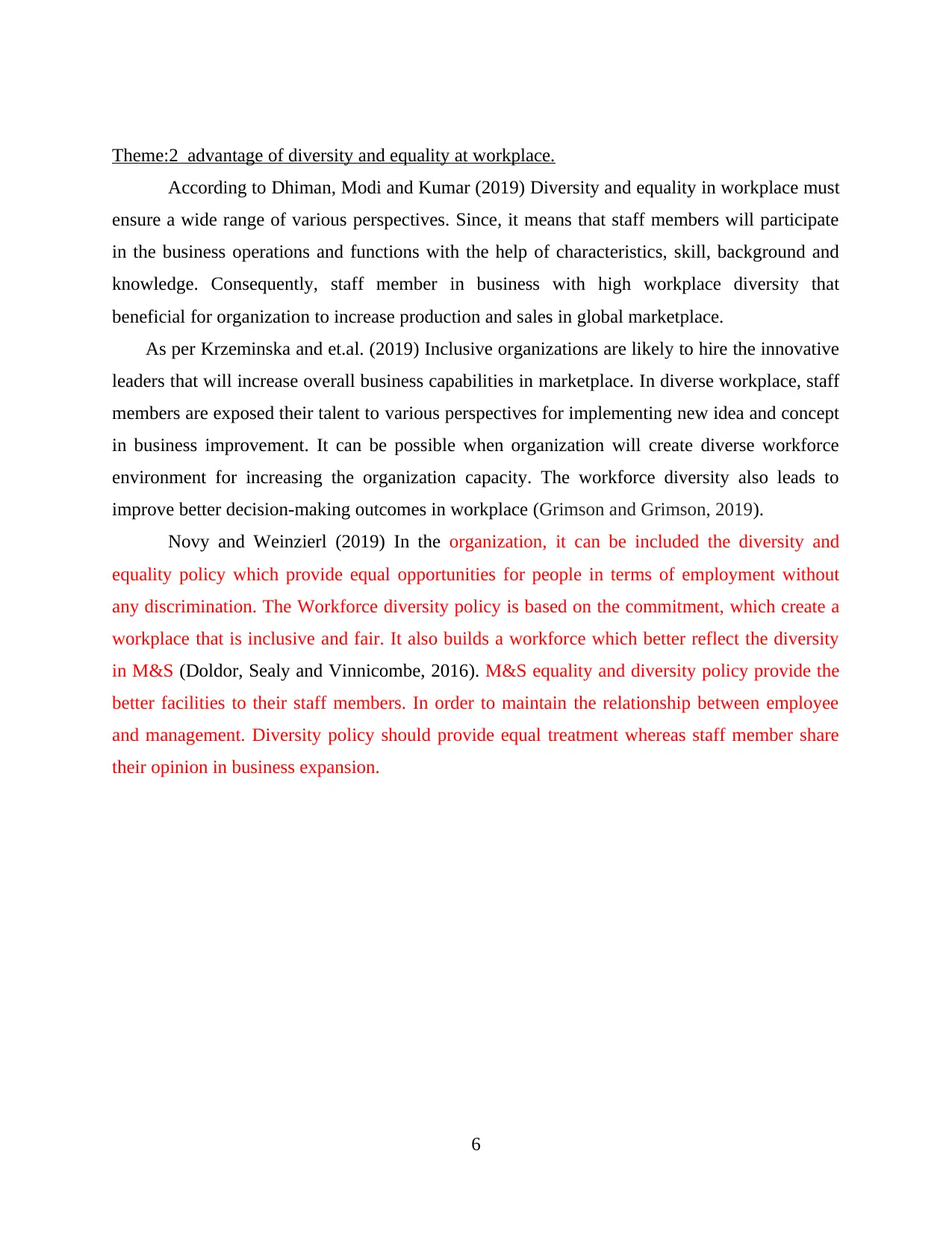
Theme:2 advantage of diversity and equality at workplace.
According to Dhiman, Modi and Kumar (2019) Diversity and equality in workplace must
ensure a wide range of various perspectives. Since, it means that staff members will participate
in the business operations and functions with the help of characteristics, skill, background and
knowledge. Consequently, staff member in business with high workplace diversity that
beneficial for organization to increase production and sales in global marketplace.
As per Krzeminska and et.al. (2019) Inclusive organizations are likely to hire the innovative
leaders that will increase overall business capabilities in marketplace. In diverse workplace, staff
members are exposed their talent to various perspectives for implementing new idea and concept
in business improvement. It can be possible when organization will create diverse workforce
environment for increasing the organization capacity. The workforce diversity also leads to
improve better decision-making outcomes in workplace (Grimson and Grimson, 2019).
Novy and Weinzierl (2019) In the organization, it can be included the diversity and
equality policy which provide equal opportunities for people in terms of employment without
any discrimination. The Workforce diversity policy is based on the commitment, which create a
workplace that is inclusive and fair. It also builds a workforce which better reflect the diversity
in M&S (Doldor, Sealy and Vinnicombe, 2016). M&S equality and diversity policy provide the
better facilities to their staff members. In order to maintain the relationship between employee
and management. Diversity policy should provide equal treatment whereas staff member share
their opinion in business expansion.
6
According to Dhiman, Modi and Kumar (2019) Diversity and equality in workplace must
ensure a wide range of various perspectives. Since, it means that staff members will participate
in the business operations and functions with the help of characteristics, skill, background and
knowledge. Consequently, staff member in business with high workplace diversity that
beneficial for organization to increase production and sales in global marketplace.
As per Krzeminska and et.al. (2019) Inclusive organizations are likely to hire the innovative
leaders that will increase overall business capabilities in marketplace. In diverse workplace, staff
members are exposed their talent to various perspectives for implementing new idea and concept
in business improvement. It can be possible when organization will create diverse workforce
environment for increasing the organization capacity. The workforce diversity also leads to
improve better decision-making outcomes in workplace (Grimson and Grimson, 2019).
Novy and Weinzierl (2019) In the organization, it can be included the diversity and
equality policy which provide equal opportunities for people in terms of employment without
any discrimination. The Workforce diversity policy is based on the commitment, which create a
workplace that is inclusive and fair. It also builds a workforce which better reflect the diversity
in M&S (Doldor, Sealy and Vinnicombe, 2016). M&S equality and diversity policy provide the
better facilities to their staff members. In order to maintain the relationship between employee
and management. Diversity policy should provide equal treatment whereas staff member share
their opinion in business expansion.
6
⊘ This is a preview!⊘
Do you want full access?
Subscribe today to unlock all pages.

Trusted by 1+ million students worldwide
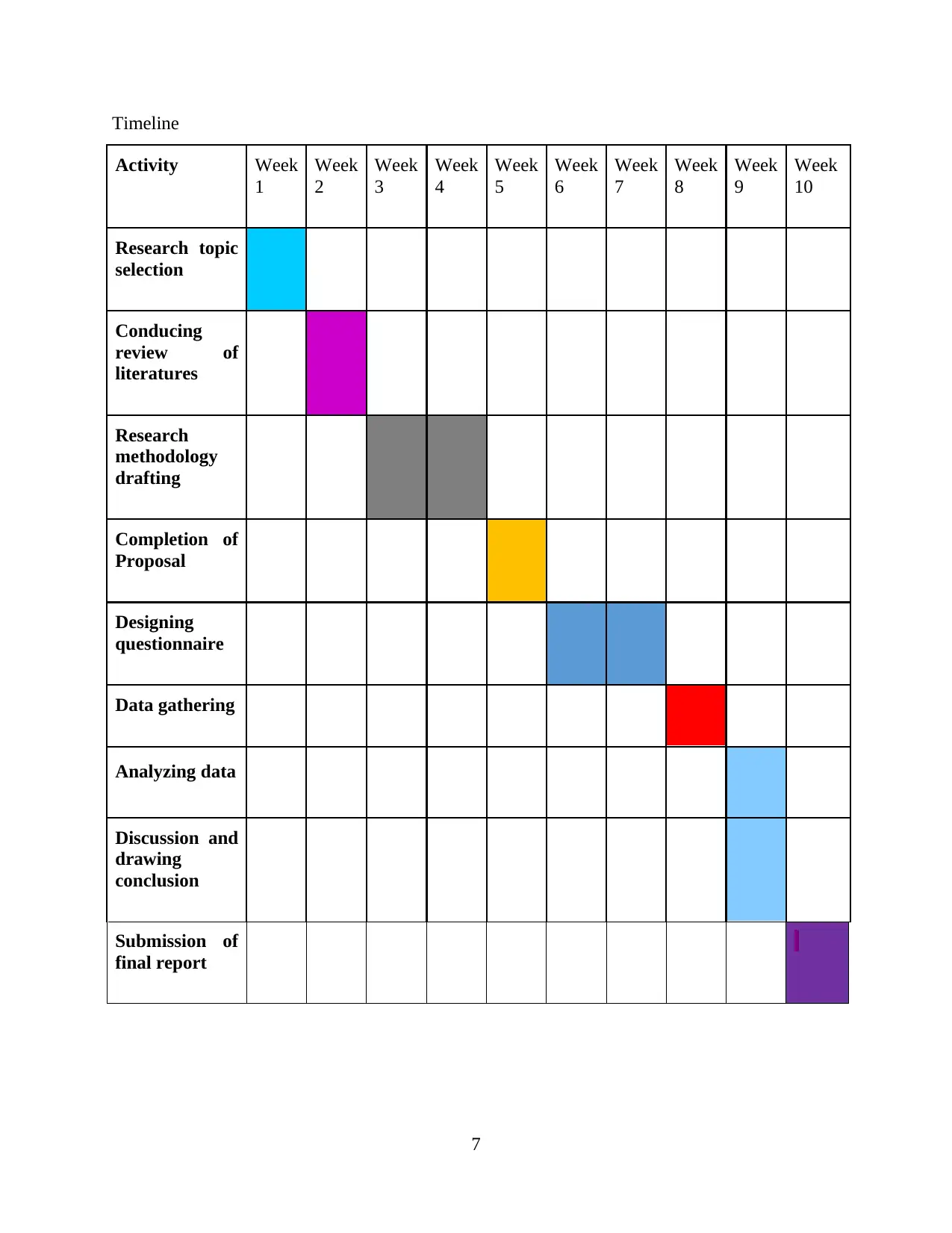
Timeline
Activity Week
1
Week
2
Week
3
Week
4
Week
5
Week
6
Week
7
Week
8
Week
9
Week
10
Research topic
selection
Conducing
review of
literatures
Research
methodology
drafting
Completion of
Proposal
Designing
questionnaire
Data gathering
Analyzing data
Discussion and
drawing
conclusion
Submission of
final report
7
Activity Week
1
Week
2
Week
3
Week
4
Week
5
Week
6
Week
7
Week
8
Week
9
Week
10
Research topic
selection
Conducing
review of
literatures
Research
methodology
drafting
Completion of
Proposal
Designing
questionnaire
Data gathering
Analyzing data
Discussion and
drawing
conclusion
Submission of
final report
7
Paraphrase This Document
Need a fresh take? Get an instant paraphrase of this document with our AI Paraphraser
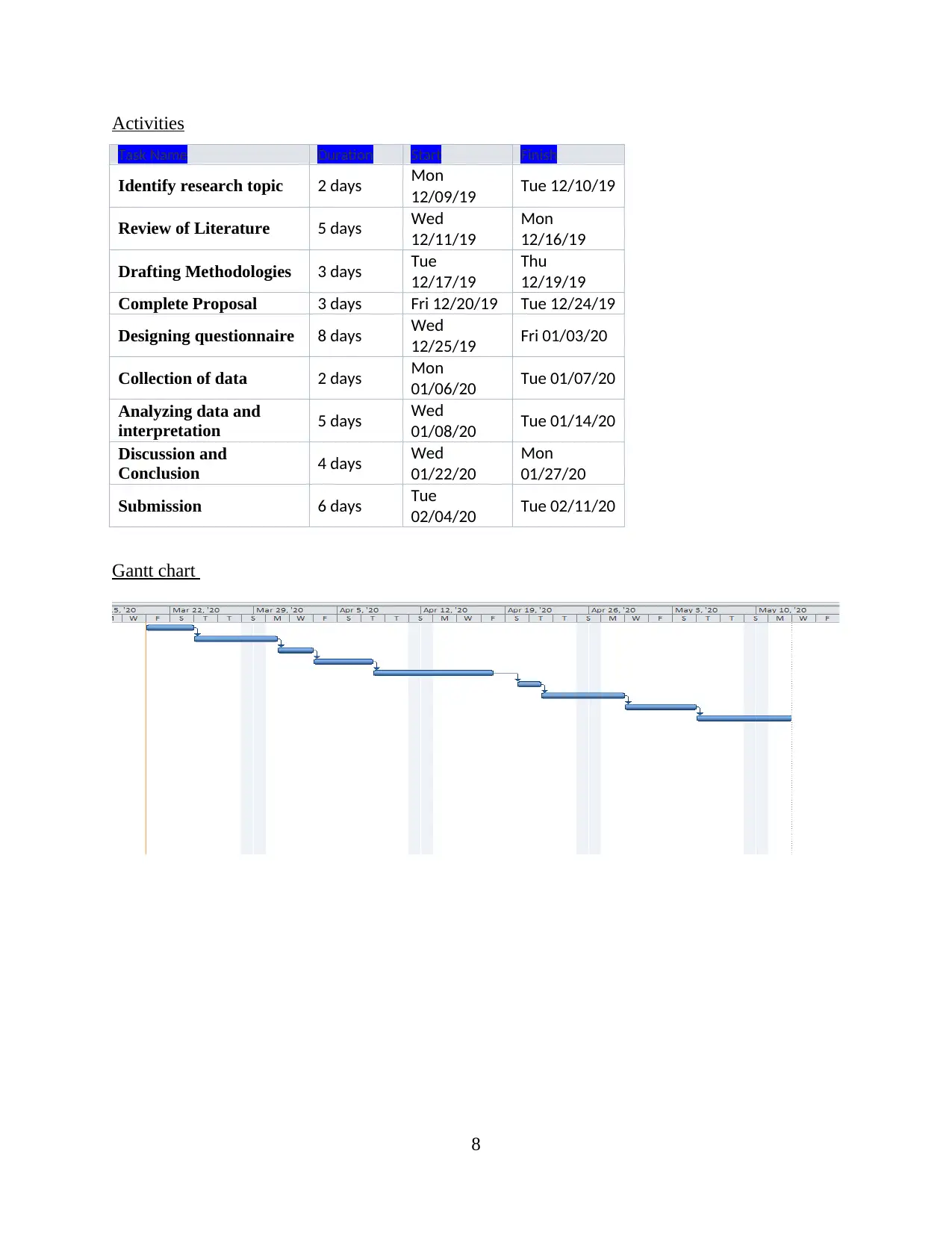
Activities
Task Name Duration Start Finish
Identify research topic 2 days Mon
12/09/19 Tue 12/10/19
Review of Literature 5 days Wed
12/11/19
Mon
12/16/19
Drafting Methodologies 3 days Tue
12/17/19
Thu
12/19/19
Complete Proposal 3 days Fri 12/20/19 Tue 12/24/19
Designing questionnaire 8 days Wed
12/25/19 Fri 01/03/20
Collection of data 2 days Mon
01/06/20 Tue 01/07/20
Analyzing data and
interpretation 5 days Wed
01/08/20 Tue 01/14/20
Discussion and
Conclusion 4 days Wed
01/22/20
Mon
01/27/20
Submission 6 days Tue
02/04/20 Tue 02/11/20
Gantt chart
8
Task Name Duration Start Finish
Identify research topic 2 days Mon
12/09/19 Tue 12/10/19
Review of Literature 5 days Wed
12/11/19
Mon
12/16/19
Drafting Methodologies 3 days Tue
12/17/19
Thu
12/19/19
Complete Proposal 3 days Fri 12/20/19 Tue 12/24/19
Designing questionnaire 8 days Wed
12/25/19 Fri 01/03/20
Collection of data 2 days Mon
01/06/20 Tue 01/07/20
Analyzing data and
interpretation 5 days Wed
01/08/20 Tue 01/14/20
Discussion and
Conclusion 4 days Wed
01/22/20
Mon
01/27/20
Submission 6 days Tue
02/04/20 Tue 02/11/20
Gantt chart
8
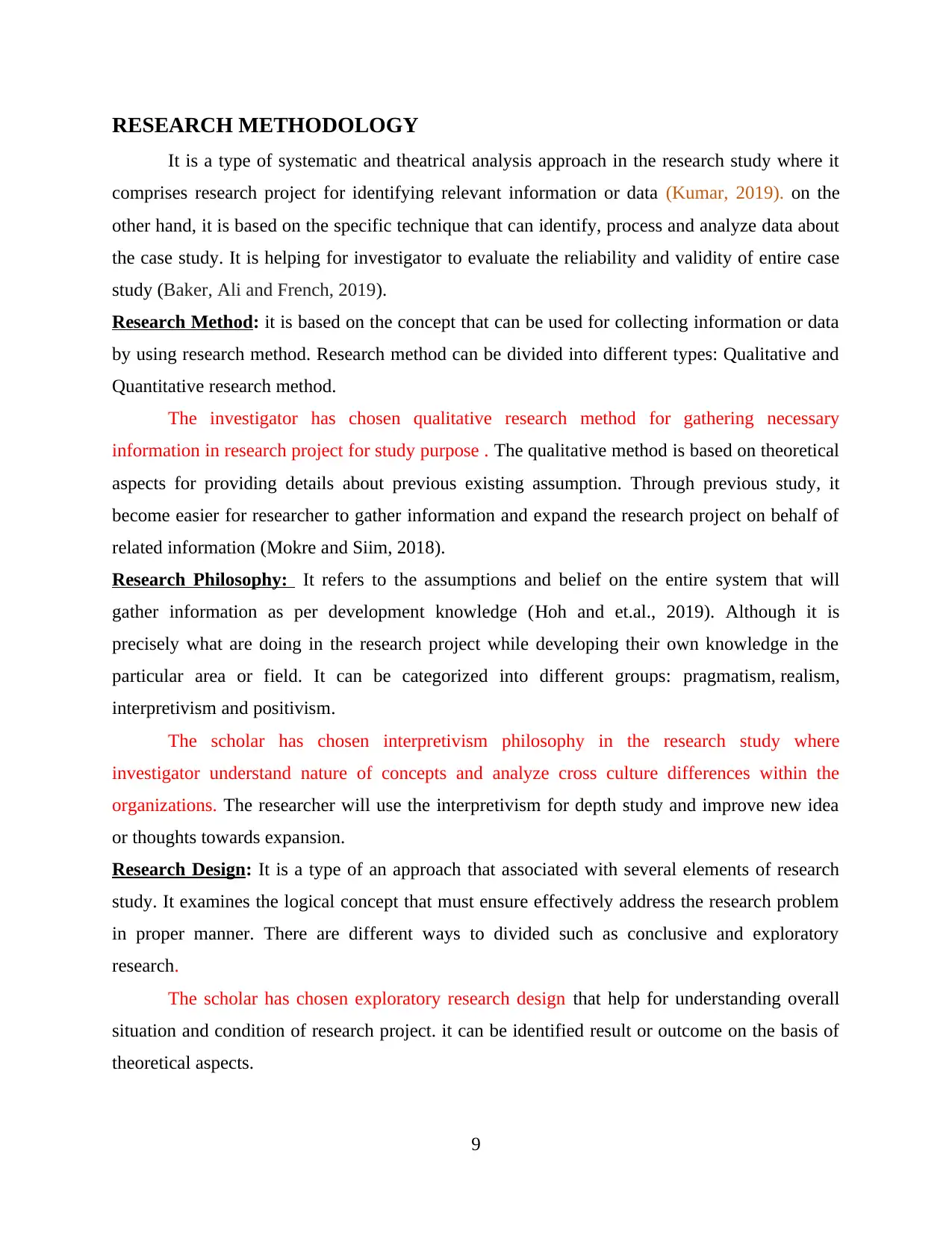
RESEARCH METHODOLOGY
It is a type of systematic and theatrical analysis approach in the research study where it
comprises research project for identifying relevant information or data (Kumar, 2019). on the
other hand, it is based on the specific technique that can identify, process and analyze data about
the case study. It is helping for investigator to evaluate the reliability and validity of entire case
study (Baker, Ali and French, 2019).
Research Method: it is based on the concept that can be used for collecting information or data
by using research method. Research method can be divided into different types: Qualitative and
Quantitative research method.
The investigator has chosen qualitative research method for gathering necessary
information in research project for study purpose . The qualitative method is based on theoretical
aspects for providing details about previous existing assumption. Through previous study, it
become easier for researcher to gather information and expand the research project on behalf of
related information (Mokre and Siim, 2018).
Research Philosophy: It refers to the assumptions and belief on the entire system that will
gather information as per development knowledge (Hoh and et.al., 2019). Although it is
precisely what are doing in the research project while developing their own knowledge in the
particular area or field. It can be categorized into different groups: pragmatism, realism,
interpretivism and positivism.
The scholar has chosen interpretivism philosophy in the research study where
investigator understand nature of concepts and analyze cross culture differences within the
organizations. The researcher will use the interpretivism for depth study and improve new idea
or thoughts towards expansion.
Research Design: It is a type of an approach that associated with several elements of research
study. It examines the logical concept that must ensure effectively address the research problem
in proper manner. There are different ways to divided such as conclusive and exploratory
research.
The scholar has chosen exploratory research design that help for understanding overall
situation and condition of research project. it can be identified result or outcome on the basis of
theoretical aspects.
9
It is a type of systematic and theatrical analysis approach in the research study where it
comprises research project for identifying relevant information or data (Kumar, 2019). on the
other hand, it is based on the specific technique that can identify, process and analyze data about
the case study. It is helping for investigator to evaluate the reliability and validity of entire case
study (Baker, Ali and French, 2019).
Research Method: it is based on the concept that can be used for collecting information or data
by using research method. Research method can be divided into different types: Qualitative and
Quantitative research method.
The investigator has chosen qualitative research method for gathering necessary
information in research project for study purpose . The qualitative method is based on theoretical
aspects for providing details about previous existing assumption. Through previous study, it
become easier for researcher to gather information and expand the research project on behalf of
related information (Mokre and Siim, 2018).
Research Philosophy: It refers to the assumptions and belief on the entire system that will
gather information as per development knowledge (Hoh and et.al., 2019). Although it is
precisely what are doing in the research project while developing their own knowledge in the
particular area or field. It can be categorized into different groups: pragmatism, realism,
interpretivism and positivism.
The scholar has chosen interpretivism philosophy in the research study where
investigator understand nature of concepts and analyze cross culture differences within the
organizations. The researcher will use the interpretivism for depth study and improve new idea
or thoughts towards expansion.
Research Design: It is a type of an approach that associated with several elements of research
study. It examines the logical concept that must ensure effectively address the research problem
in proper manner. There are different ways to divided such as conclusive and exploratory
research.
The scholar has chosen exploratory research design that help for understanding overall
situation and condition of research project. it can be identified result or outcome on the basis of
theoretical aspects.
9
⊘ This is a preview!⊘
Do you want full access?
Subscribe today to unlock all pages.

Trusted by 1+ million students worldwide
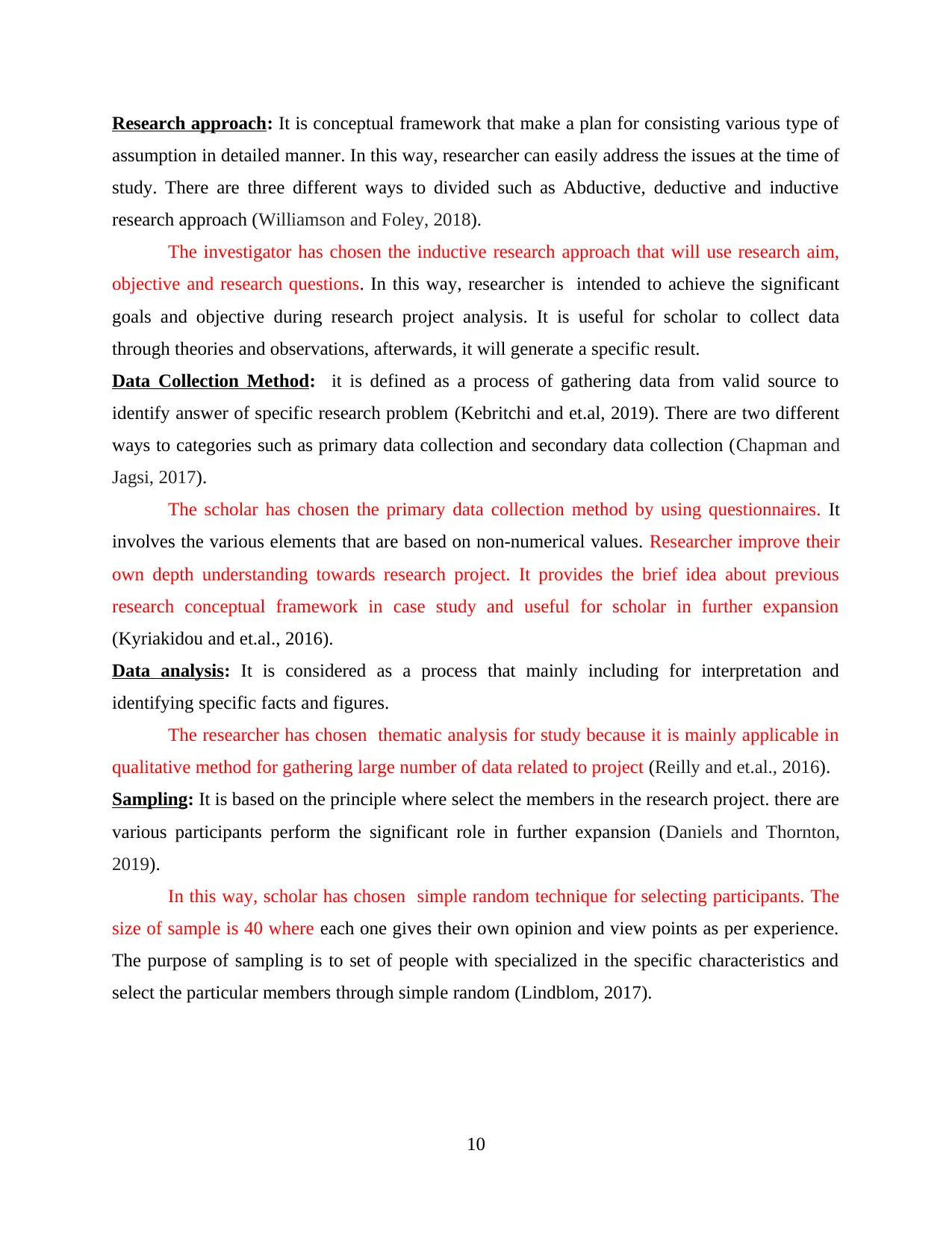
Research approach: It is conceptual framework that make a plan for consisting various type of
assumption in detailed manner. In this way, researcher can easily address the issues at the time of
study. There are three different ways to divided such as Abductive, deductive and inductive
research approach (Williamson and Foley, 2018).
The investigator has chosen the inductive research approach that will use research aim,
objective and research questions. In this way, researcher is intended to achieve the significant
goals and objective during research project analysis. It is useful for scholar to collect data
through theories and observations, afterwards, it will generate a specific result.
Data Collection Method: it is defined as a process of gathering data from valid source to
identify answer of specific research problem (Kebritchi and et.al, 2019). There are two different
ways to categories such as primary data collection and secondary data collection (Chapman and
Jagsi, 2017).
The scholar has chosen the primary data collection method by using questionnaires. It
involves the various elements that are based on non-numerical values. Researcher improve their
own depth understanding towards research project. It provides the brief idea about previous
research conceptual framework in case study and useful for scholar in further expansion
(Kyriakidou and et.al., 2016).
Data analysis: It is considered as a process that mainly including for interpretation and
identifying specific facts and figures.
The researcher has chosen thematic analysis for study because it is mainly applicable in
qualitative method for gathering large number of data related to project (Reilly and et.al., 2016).
Sampling: It is based on the principle where select the members in the research project. there are
various participants perform the significant role in further expansion (Daniels and Thornton,
2019).
In this way, scholar has chosen simple random technique for selecting participants. The
size of sample is 40 where each one gives their own opinion and view points as per experience.
The purpose of sampling is to set of people with specialized in the specific characteristics and
select the particular members through simple random (Lindblom, 2017).
10
assumption in detailed manner. In this way, researcher can easily address the issues at the time of
study. There are three different ways to divided such as Abductive, deductive and inductive
research approach (Williamson and Foley, 2018).
The investigator has chosen the inductive research approach that will use research aim,
objective and research questions. In this way, researcher is intended to achieve the significant
goals and objective during research project analysis. It is useful for scholar to collect data
through theories and observations, afterwards, it will generate a specific result.
Data Collection Method: it is defined as a process of gathering data from valid source to
identify answer of specific research problem (Kebritchi and et.al, 2019). There are two different
ways to categories such as primary data collection and secondary data collection (Chapman and
Jagsi, 2017).
The scholar has chosen the primary data collection method by using questionnaires. It
involves the various elements that are based on non-numerical values. Researcher improve their
own depth understanding towards research project. It provides the brief idea about previous
research conceptual framework in case study and useful for scholar in further expansion
(Kyriakidou and et.al., 2016).
Data analysis: It is considered as a process that mainly including for interpretation and
identifying specific facts and figures.
The researcher has chosen thematic analysis for study because it is mainly applicable in
qualitative method for gathering large number of data related to project (Reilly and et.al., 2016).
Sampling: It is based on the principle where select the members in the research project. there are
various participants perform the significant role in further expansion (Daniels and Thornton,
2019).
In this way, scholar has chosen simple random technique for selecting participants. The
size of sample is 40 where each one gives their own opinion and view points as per experience.
The purpose of sampling is to set of people with specialized in the specific characteristics and
select the particular members through simple random (Lindblom, 2017).
10
Paraphrase This Document
Need a fresh take? Get an instant paraphrase of this document with our AI Paraphraser
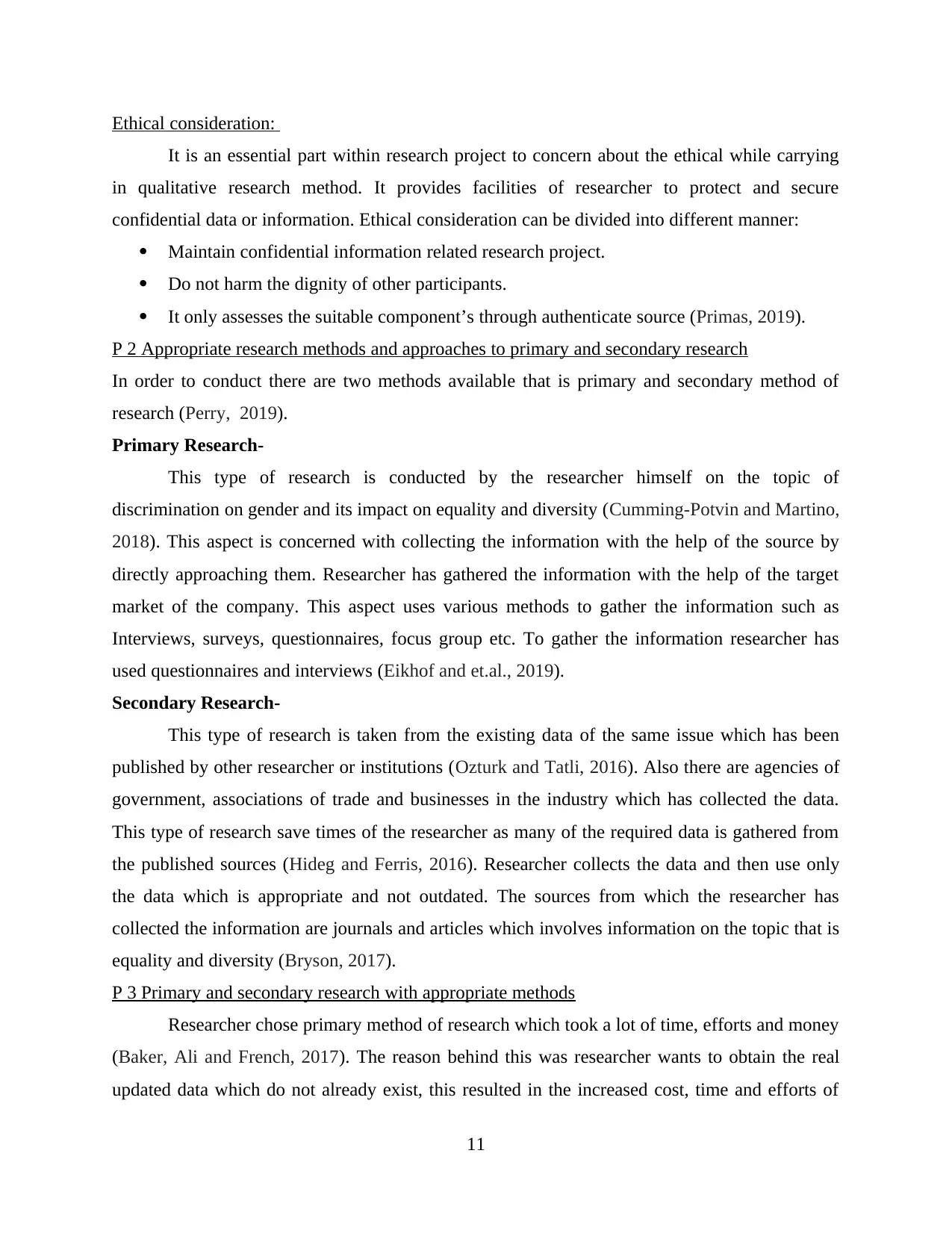
Ethical consideration:
It is an essential part within research project to concern about the ethical while carrying
in qualitative research method. It provides facilities of researcher to protect and secure
confidential data or information. Ethical consideration can be divided into different manner:
Maintain confidential information related research project.
Do not harm the dignity of other participants.
It only assesses the suitable component’s through authenticate source (Primas, 2019).
P 2 Appropriate research methods and approaches to primary and secondary research
In order to conduct there are two methods available that is primary and secondary method of
research (Perry, 2019).
Primary Research-
This type of research is conducted by the researcher himself on the topic of
discrimination on gender and its impact on equality and diversity (Cumming-Potvin and Martino,
2018). This aspect is concerned with collecting the information with the help of the source by
directly approaching them. Researcher has gathered the information with the help of the target
market of the company. This aspect uses various methods to gather the information such as
Interviews, surveys, questionnaires, focus group etc. To gather the information researcher has
used questionnaires and interviews (Eikhof and et.al., 2019).
Secondary Research-
This type of research is taken from the existing data of the same issue which has been
published by other researcher or institutions (Ozturk and Tatli, 2016). Also there are agencies of
government, associations of trade and businesses in the industry which has collected the data.
This type of research save times of the researcher as many of the required data is gathered from
the published sources (Hideg and Ferris, 2016). Researcher collects the data and then use only
the data which is appropriate and not outdated. The sources from which the researcher has
collected the information are journals and articles which involves information on the topic that is
equality and diversity (Bryson, 2017).
P 3 Primary and secondary research with appropriate methods
Researcher chose primary method of research which took a lot of time, efforts and money
(Baker, Ali and French, 2017). The reason behind this was researcher wants to obtain the real
updated data which do not already exist, this resulted in the increased cost, time and efforts of
11
It is an essential part within research project to concern about the ethical while carrying
in qualitative research method. It provides facilities of researcher to protect and secure
confidential data or information. Ethical consideration can be divided into different manner:
Maintain confidential information related research project.
Do not harm the dignity of other participants.
It only assesses the suitable component’s through authenticate source (Primas, 2019).
P 2 Appropriate research methods and approaches to primary and secondary research
In order to conduct there are two methods available that is primary and secondary method of
research (Perry, 2019).
Primary Research-
This type of research is conducted by the researcher himself on the topic of
discrimination on gender and its impact on equality and diversity (Cumming-Potvin and Martino,
2018). This aspect is concerned with collecting the information with the help of the source by
directly approaching them. Researcher has gathered the information with the help of the target
market of the company. This aspect uses various methods to gather the information such as
Interviews, surveys, questionnaires, focus group etc. To gather the information researcher has
used questionnaires and interviews (Eikhof and et.al., 2019).
Secondary Research-
This type of research is taken from the existing data of the same issue which has been
published by other researcher or institutions (Ozturk and Tatli, 2016). Also there are agencies of
government, associations of trade and businesses in the industry which has collected the data.
This type of research save times of the researcher as many of the required data is gathered from
the published sources (Hideg and Ferris, 2016). Researcher collects the data and then use only
the data which is appropriate and not outdated. The sources from which the researcher has
collected the information are journals and articles which involves information on the topic that is
equality and diversity (Bryson, 2017).
P 3 Primary and secondary research with appropriate methods
Researcher chose primary method of research which took a lot of time, efforts and money
(Baker, Ali and French, 2017). The reason behind this was researcher wants to obtain the real
updated data which do not already exist, this resulted in the increased cost, time and efforts of
11
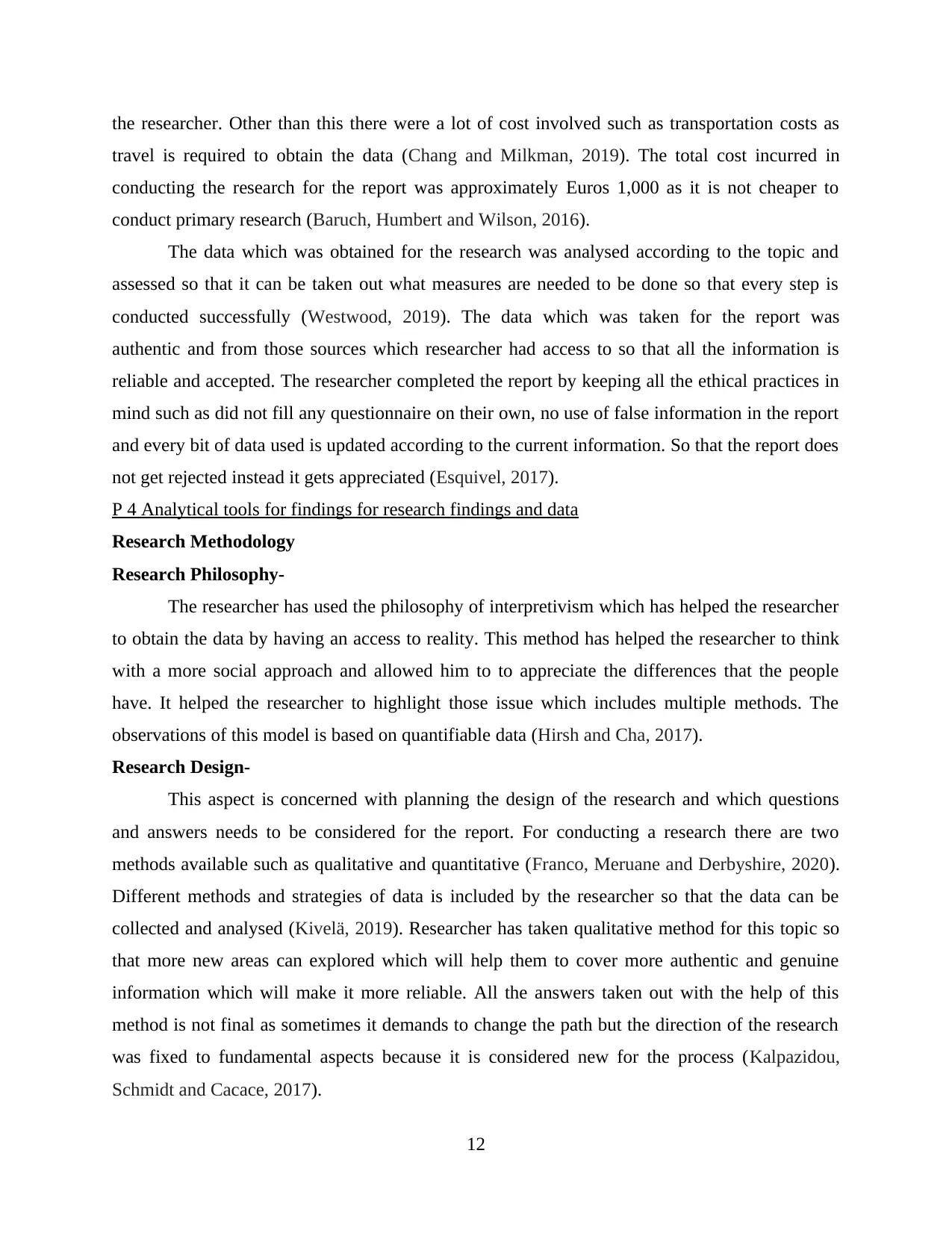
the researcher. Other than this there were a lot of cost involved such as transportation costs as
travel is required to obtain the data (Chang and Milkman, 2019). The total cost incurred in
conducting the research for the report was approximately Euros 1,000 as it is not cheaper to
conduct primary research (Baruch, Humbert and Wilson, 2016).
The data which was obtained for the research was analysed according to the topic and
assessed so that it can be taken out what measures are needed to be done so that every step is
conducted successfully (Westwood, 2019). The data which was taken for the report was
authentic and from those sources which researcher had access to so that all the information is
reliable and accepted. The researcher completed the report by keeping all the ethical practices in
mind such as did not fill any questionnaire on their own, no use of false information in the report
and every bit of data used is updated according to the current information. So that the report does
not get rejected instead it gets appreciated (Esquivel, 2017).
P 4 Analytical tools for findings for research findings and data
Research Methodology
Research Philosophy-
The researcher has used the philosophy of interpretivism which has helped the researcher
to obtain the data by having an access to reality. This method has helped the researcher to think
with a more social approach and allowed him to to appreciate the differences that the people
have. It helped the researcher to highlight those issue which includes multiple methods. The
observations of this model is based on quantifiable data (Hirsh and Cha, 2017).
Research Design-
This aspect is concerned with planning the design of the research and which questions
and answers needs to be considered for the report. For conducting a research there are two
methods available such as qualitative and quantitative (Franco, Meruane and Derbyshire, 2020).
Different methods and strategies of data is included by the researcher so that the data can be
collected and analysed (Kivelä, 2019). Researcher has taken qualitative method for this topic so
that more new areas can explored which will help them to cover more authentic and genuine
information which will make it more reliable. All the answers taken out with the help of this
method is not final as sometimes it demands to change the path but the direction of the research
was fixed to fundamental aspects because it is considered new for the process (Kalpazidou,
Schmidt and Cacace, 2017).
12
travel is required to obtain the data (Chang and Milkman, 2019). The total cost incurred in
conducting the research for the report was approximately Euros 1,000 as it is not cheaper to
conduct primary research (Baruch, Humbert and Wilson, 2016).
The data which was obtained for the research was analysed according to the topic and
assessed so that it can be taken out what measures are needed to be done so that every step is
conducted successfully (Westwood, 2019). The data which was taken for the report was
authentic and from those sources which researcher had access to so that all the information is
reliable and accepted. The researcher completed the report by keeping all the ethical practices in
mind such as did not fill any questionnaire on their own, no use of false information in the report
and every bit of data used is updated according to the current information. So that the report does
not get rejected instead it gets appreciated (Esquivel, 2017).
P 4 Analytical tools for findings for research findings and data
Research Methodology
Research Philosophy-
The researcher has used the philosophy of interpretivism which has helped the researcher
to obtain the data by having an access to reality. This method has helped the researcher to think
with a more social approach and allowed him to to appreciate the differences that the people
have. It helped the researcher to highlight those issue which includes multiple methods. The
observations of this model is based on quantifiable data (Hirsh and Cha, 2017).
Research Design-
This aspect is concerned with planning the design of the research and which questions
and answers needs to be considered for the report. For conducting a research there are two
methods available such as qualitative and quantitative (Franco, Meruane and Derbyshire, 2020).
Different methods and strategies of data is included by the researcher so that the data can be
collected and analysed (Kivelä, 2019). Researcher has taken qualitative method for this topic so
that more new areas can explored which will help them to cover more authentic and genuine
information which will make it more reliable. All the answers taken out with the help of this
method is not final as sometimes it demands to change the path but the direction of the research
was fixed to fundamental aspects because it is considered new for the process (Kalpazidou,
Schmidt and Cacace, 2017).
12
⊘ This is a preview!⊘
Do you want full access?
Subscribe today to unlock all pages.

Trusted by 1+ million students worldwide
1 out of 34
Related Documents
Your All-in-One AI-Powered Toolkit for Academic Success.
+13062052269
info@desklib.com
Available 24*7 on WhatsApp / Email
![[object Object]](/_next/static/media/star-bottom.7253800d.svg)
Unlock your academic potential
Copyright © 2020–2025 A2Z Services. All Rights Reserved. Developed and managed by ZUCOL.





